pH measures how acidic or alkaline your skin is, which is essential for maintaining a healthy skin barrier. Your skin’s natural pH is slightly acidic, around 4.5 to 5.5, helping protect against bacteria and keep moisture in. When pH is off, your skin can become dry, irritated, or prone to breakouts. Understanding and maintaining your skin’s pH helps keep it balanced, resilient, and youthful—if you want to discover how, keep exploring.
Key Takeaways
- pH measures the acidity or alkalinity of skincare products, influencing their effectiveness and skin compatibility.
- The skin’s natural pH ranges from 4.5 to 5.5, maintaining a healthy barrier and microbiome.
- Proper pH helps prevent dryness, irritation, breakouts, and supports aging resistance by maintaining barrier strength.
- Skincare products formulated with balanced pH preserve skin health and enhance hydration and resilience.
- Regular pH testing with indicator strips or meters ensures products and skin stay within optimal acidity levels.
Understanding Ph and Its Measurement

Have you ever wondered how the acidity or alkalinity of your skincare products is determined? It’s done through simple skin pH testing. This process measures the pH level, which indicates whether a product is acidic, neutral, or alkaline. To do this accurately, you can use pH indicator strips—tiny strips coated with chemicals that change color based on the pH level they contact. When you apply a strip to your skin or a product, it reacts instantly, showing a color that you compare to a chart. This quick method helps you understand the pH balance of your skincare. Knowing your skin’s pH can guide you in choosing products that maintain healthy skin barrier function and avoid irritation. It’s a simple, effective way to stay informed about your skincare. Additionally, understanding your skin’s pH can help you leverage industry transformations and select innovative products designed for optimal balance.
The Science Behind Ph Levels in Skin
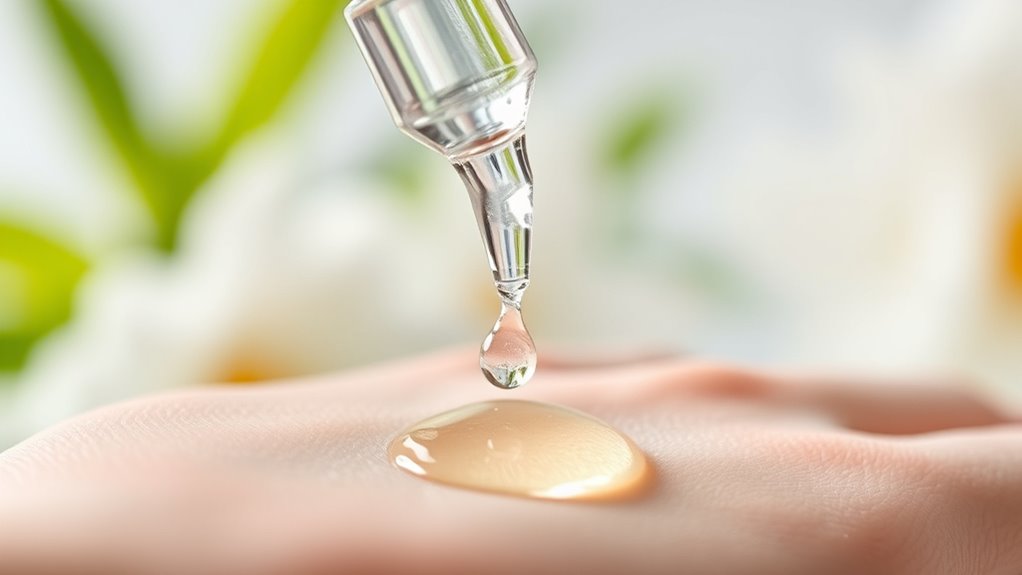
Understanding how pH levels affect your skin requires a look at the underlying science. Your skin’s surface maintains a slightly acidic pH, usually between 4.5 and 5.5, which supports a healthy skin microbiome. This balance prevents harmful bacteria from thriving and keeps your skin resilient. pH testing helps determine whether your skin’s acidity is within this ideal range. When your skin’s pH shifts too high or too low, it can disrupt the microbiome, leading to issues like dryness, irritation, or breakouts. The acidity level influences various skin processes, including enzyme activity and barrier function. Maintaining the correct skin pH balance is essential for overall skin health and protection. By understanding the science behind pH levels, you can better appreciate how maintaining the right balance helps keep your skin healthy and protected.
How Ph Affects Your Skin’S Barrier Function
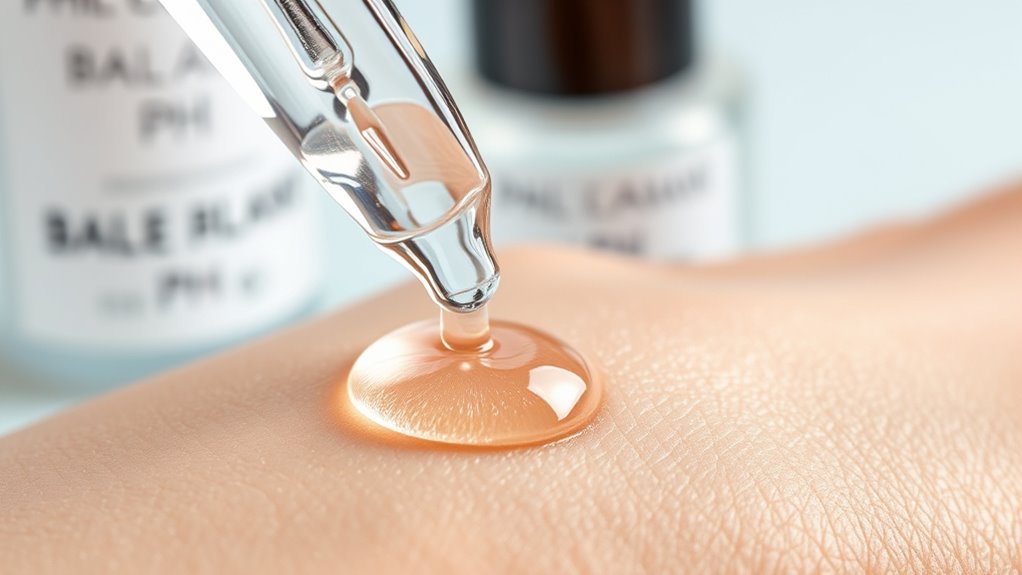
Your skin’s barrier works best when your pH stays slightly acidic, helping it stay strong and protect against irritants. When the pH becomes too alkaline, that barrier weakens, making your skin more vulnerable. Maintaining the right pH level is key to keeping your skin healthy and resilient. Using skincare products with proper HEPA filtration can help remove pollutants and allergens that may disrupt your skin’s balance.
Acidic Ph Preserves Barrier
Since the skin’s surface naturally maintains an acidic pH, this environment plays a crucial role in preserving the skin’s barrier function. An acidic pH helps regulate pH and skin hydration, keeping your skin supple and resilient. When your skin stays within its ideal pH range, it effectively blocks harmful bacteria and pollutants, reducing the risk of irritation and infection. Additionally, a balanced acidic pH slows skin aging by supporting collagen production and preventing damage from free radicals. If the pH shifts away from the natural acidity, your barrier becomes compromised, leading to increased moisture loss and vulnerability. Maintaining an acidic pH through proper skincare helps preserve your skin’s overall health, ensuring it remains hydrated, youthful, and protected against environmental stressors. Proper pH balance also supports skin hydration, which is essential for maintaining a healthy and luminous complexion.
Alkaline Ph Weakens Defense
When the skin’s pH rises above its natural acidity, becoming more alkaline, its protective barrier weakens. pH measurement shows that a balanced acid mantle is essential for healthy skin. An overly alkaline environment disrupts the skin’s alkaline balance, impairing the function of lipids and proteins that maintain barrier integrity. This makes your skin more vulnerable to irritants, bacteria, and moisture loss. As the barrier weakens, you may notice increased dryness, redness, and sensitivity. Maintaining the proper pH level helps keep your skin resilient and better able to defend against external stressors. When your skin’s pH shifts toward alkalinity, it’s a sign that its natural defense system is compromised. To support a strong barrier, aim to use skincare products that preserve the skin’s ideal pH measurement and alkaline balance. Additionally, understanding how projector contrast ratio affects image quality can be useful when creating a comfortable home cinema environment.
Typical Ph Range of Healthy Skin

The typical pH range of healthy skin generally falls between 4.5 and 5.5. This slightly acidic level helps maintain your skin’s microbiome, which is essential for a strong defense against harmful bacteria and infections. When your skin’s pH stays within this range, it supports the natural barrier function, keeping moisture in and irritants out. Regular pH testing can help you monitor your skin’s balance and identify if products or environmental factors are disrupting it. If your skin’s pH drifts outside this range, it can lead to issues like dryness, sensitivity, or breakouts. Maintaining proper skin pH balance is crucial for overall skin health. Understanding this typical pH range empowers you to choose skincare products that support your skin’s natural acidity and overall health.
Common Skincare Products and Their Ph Levels

Have you ever wondered about the pH levels of your skincare products? pH testing helps determine whether your cleansers, toners, and serums fall within suitable ranges for skin health. Most skincare formulations are designed with specific pH levels to guarantee effectiveness and gentle action. For example, gentle cleansers often have a pH around 5.5, close to your skin’s natural acidity, while exfoliants like acids tend to be more acidic, with pH values below 4. Understanding these levels helps you choose products that support your skin’s balance. Checking the pH of your products can prevent irritation and maintain healthy skin. Knowing the pH levels of common skincare items empowers you to make informed choices and maximize your skincare routine. Detecting passive voice can improve your writing clarity and style.
The Impact of Ph Imbalance on Skin Conditions
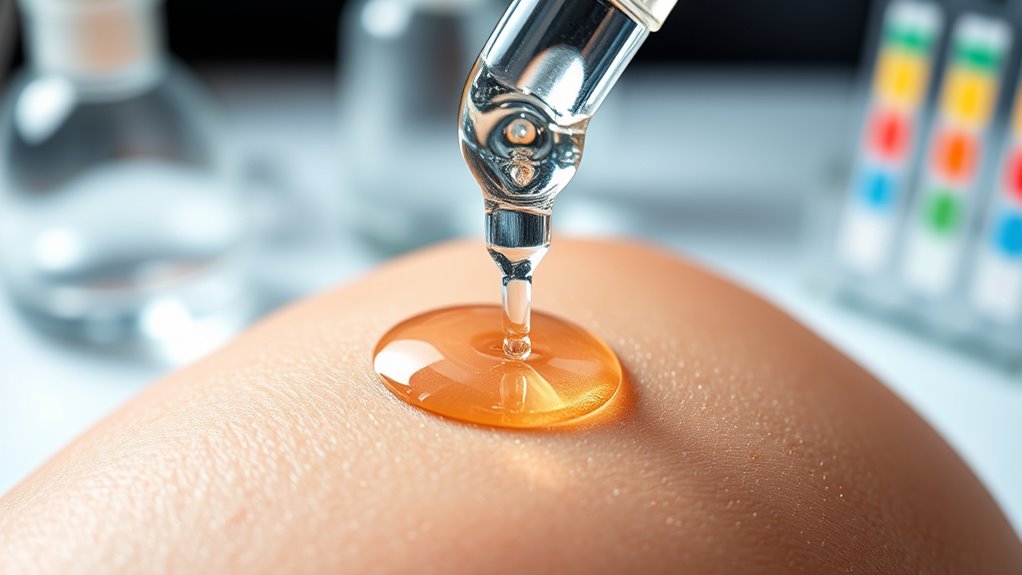
Maintaining the right pH balance in your skincare routine is vital because imbalances can lead to a range of skin issues. When your skin’s pH shifts, it affects skin acidity, disrupting the natural barrier. This can cause dryness, irritation, and even acne. Using pH testing helps you monitor your skin’s health and choose products that support a balanced environment. A pH that’s too high (alkaline) weakens the skin’s defenses, while too low (acidic) may cause sensitivity. Keep in mind that consistent skin acidity maintains hydration and protects against bacteria. Here’s a quick overview:
| pH Level | Effect on Skin | Common Conditions |
|---|---|---|
| 4.5–5.5 | Balanced skin | Healthy, hydrated |
| Below 4.5 | Too acidic | Sensitivity, redness |
| Above 5.5 | Too alkaline | Dryness, breakouts |
Regular use of glycolic acid products can help maintain this delicate balance by promoting gentle exfoliation without disrupting skin’s natural pH.
Signs That Your Skin’S Ph Is off Balance

When your skin’s pH is out of balance, it often shows through noticeable changes in your skin’s appearance and feel. You might notice increased dryness or oiliness, indicating disrupted pH and skin hydration. Your skin may become more sensitive, prone to redness, or develop irritation because an unbalanced pH weakens the skin’s protective barrier. Over time, a skewed pH can accelerate skin aging, leading to fine lines and dullness. You may also see breakouts or flakiness, which are signs that your skin’s natural balance is disrupted. These signs are clear indicators that your skin’s pH needs attention to maintain ideal hydration, resilience, and a youthful glow. Staying informed about personal debt forgiveness bills can help you understand broader financial health impacts that may indirectly influence your skincare and wellness routines. Recognizing these signs early helps you take steps to restore your skin’s natural balance.
Tips for Maintaining Your Skin’S Natural Ph
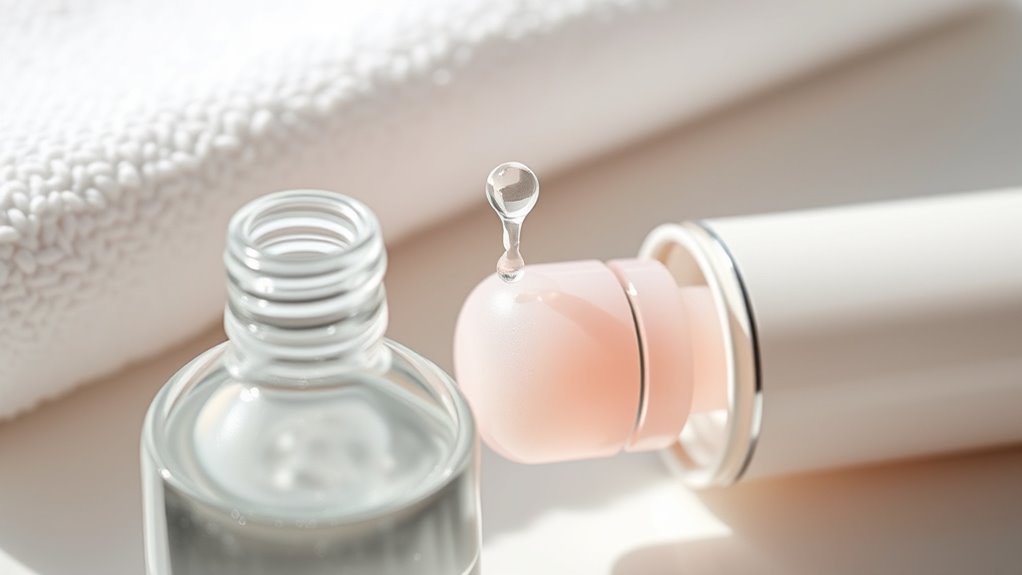
To keep your skin’s natural pH balanced, choose gentle cleansers that don’t strip away your skin’s oils. Incorporate toners into your routine to help restore and maintain the right pH level. These simple steps can make a big difference in supporting healthy, resilient skin.
Use Gentle Cleansers
Choosing the right cleanser is essential for preserving your skin’s natural pH balance. Gentle cleansers are your best option, especially if you have sensitive skin. These formulas effectively remove dirt and excess oil without stripping away your skin’s protective barrier or disrupting its pH. Harsh soaps and strong cleansers can upset your skin sensitivity, leading to dryness, irritation, or breakouts. Look for products labeled as pH-balanced or designed for sensitive skin to ensure they won’t alter your skin’s natural acidity. Using gentle cleansers helps maintain a healthy, balanced environment on your skin’s surface. This simple step supports your overall skincare routine and keeps your skin looking fresh, smooth, and resilient. Always choose products that respect your skin’s delicate balance.
Balance With Toners
Balancing your skin’s pH with toners is a key step to maintaining its natural acidity and overall health. Choosing the right balancing toners helps restore your skin’s ideal pH level after cleansing, preventing dryness or excess oil. You can also perform pH testing with simple strips to monitor your skin’s condition. When selecting a toner, look for ingredients that support your skin’s natural barrier, like witch hazel or rose water. Regular pH testing ensures your routine stays effective and prevents pH imbalance. Keep in mind, overusing harsh toners can disrupt your skin’s natural acidity. Use them wisely to maintain a healthy, balanced complexion. Understanding the importance of skin health can help you make better choices for your skincare routine.
Choosing Ph-Balanced Products for Better Skincare
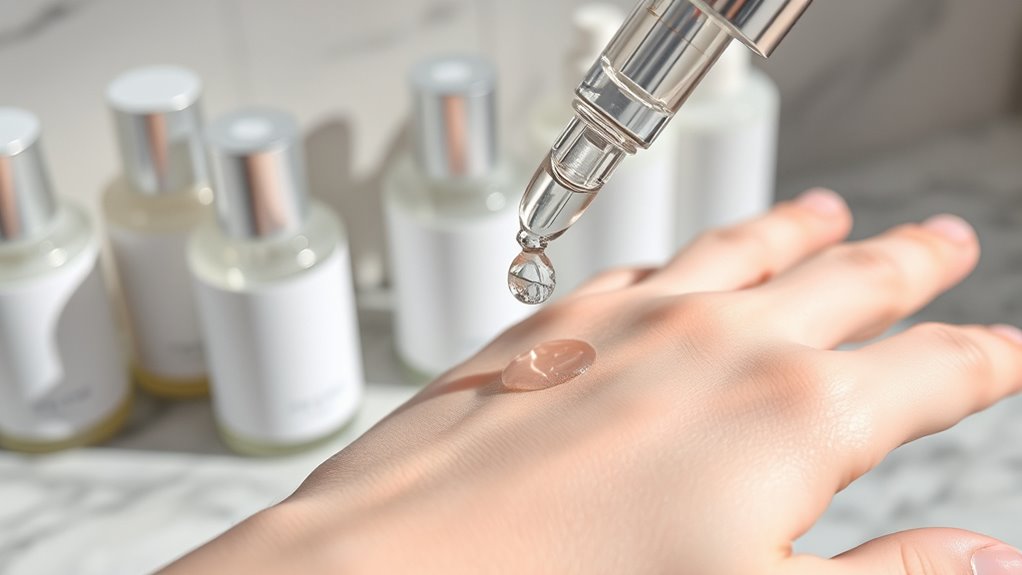
Selecting skincare products with the right pH level can markedly improve your skin’s health and appearance. When choosing pH-balanced products, consider how pH influences aging; products that match your skin’s natural pH help reduce fine lines and wrinkles over time. Additionally, pH plays a role in sun protection—products with a proper pH can strengthen your skin’s barrier, making it more resistant to UV damage. Look for formulas labeled as pH-balanced, typically around 4.5 to 5.5, which support your skin’s natural acidity. Avoid overly alkaline or acidic products that can disrupt this balance, leading to irritation or increased sensitivity. By selecting the right pH-balanced skincare, you actively support your skin’s resilience and youthful glow.
The Role of Ph in Preventing Skin Problems
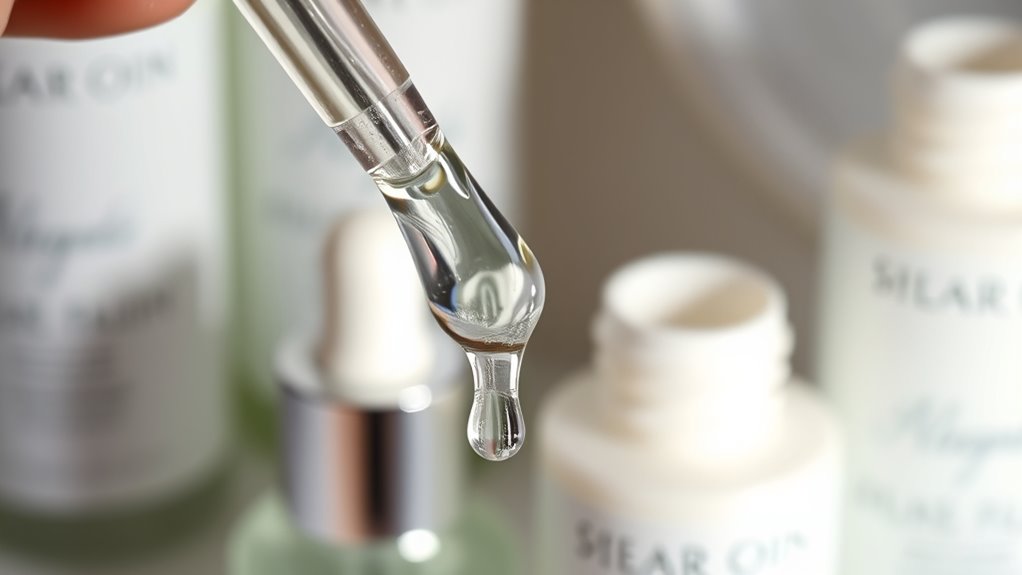
Maintaining the proper pH level on your skin is essential for preventing common issues like acne, irritation, and sensitivity. When your skin’s pH is balanced, it supports the skin’s natural barrier, reducing vulnerability to bacteria and environmental stressors. Using accurate pH measurement techniques helps you monitor your skin’s pH variability, which can fluctuate due to products, environment, or health. Be aware that skin pH variability is normal, but significant shifts can lead to problems. To keep your skin healthy, choose products that respect your skin’s natural pH. Regularly test your skin’s pH to catch imbalances early. This proactive approach minimizes skin problems and maintains a resilient, clear complexion.
| pH Measurement Techniques | Skin pH Variability |
|---|---|
| pH strips | Daily fluctuations |
| Electronic pH meters | Environmental factors |
| Swab testing | Product use impacts |
| Buffered solutions | Hormonal changes |
| Indicator dyes | Age-related shifts |
Frequently Asked Questions
Can Diet Influence My Skin’s Ph Levels?
Your diet can definitely influence your skin’s pH levels because it impacts pH regulation. Consuming highly processed foods or sugary drinks might disrupt your skin’s natural balance, making it more acidic or alkaline than ideal. Eating a balanced diet rich in fruits, vegetables, and hydration helps maintain proper pH regulation, supporting healthier skin. So, yes, your dietary choices can play a significant role in keeping your skin’s pH in check.
Does Water Ph Affect Skin Health?
Did you know that over 80% of skin issues are linked to imbalance in pH levels? Water pH can impact your skin health by affecting skin hydration and bacteria balance. If your water is too alkaline or acidic, it might strip natural oils or disrupt good bacteria, leading to irritation or dryness. Using balanced, pH-friendly water helps maintain ideal hydration and keeps bacteria in check, promoting healthier, more resilient skin.
How Often Should I Test My Skin’S Ph?
You should perform pH testing on your skin once a week to keep your skincare routine effective. Regular pH testing helps you monitor your skin’s acidity, ensuring your products aren’t disrupting its natural balance. If you notice irritation or breakouts, consider testing more frequently. Keeping track of your skin’s pH allows you to adjust your skincare routine accordingly, promoting healthier, happier skin over time.
Are Natural or Organic Skincare Products Better for Ph Balance?
You might find it surprising, but natural or organic skincare products can be better for pH balance because they often contain gentle ingredients that support your skin’s natural acidity. When pH testing, look for products with carefully selected ingredients designed to maintain or restore your skin’s ideal pH. By choosing wisely, you help keep your skin healthy, balanced, and resilient, making your skincare routine even more effective.
What Are the Long-Term Effects of Ph Imbalance on Skin Aging?
Ignoring pH balance can weaken your skin barrier over time, leading to increased sensitivity and faster aging. When your skin’s pH is off, it hampers collagen production and accelerates collagen degradation, making fine lines and wrinkles more prominent. Long-term, this imbalance can cause your skin to lose elasticity and firmness, speeding up the aging process. To maintain youthful, resilient skin, keep your pH balanced and support your skin’s natural defenses.
Conclusion
Understanding your skin’s pH isn’t just skincare jargon — it’s key to keeping your skin healthy and balanced. Many believe that using pH-balanced products prevents issues like dryness or breakouts, and studies support this. When you pay attention to your skin’s pH, you’re helping your barrier stay strong and resilient. So, by choosing the right products and maintaining your skin’s natural level, you’re giving your skin the best shot at staying radiant and healthy.









